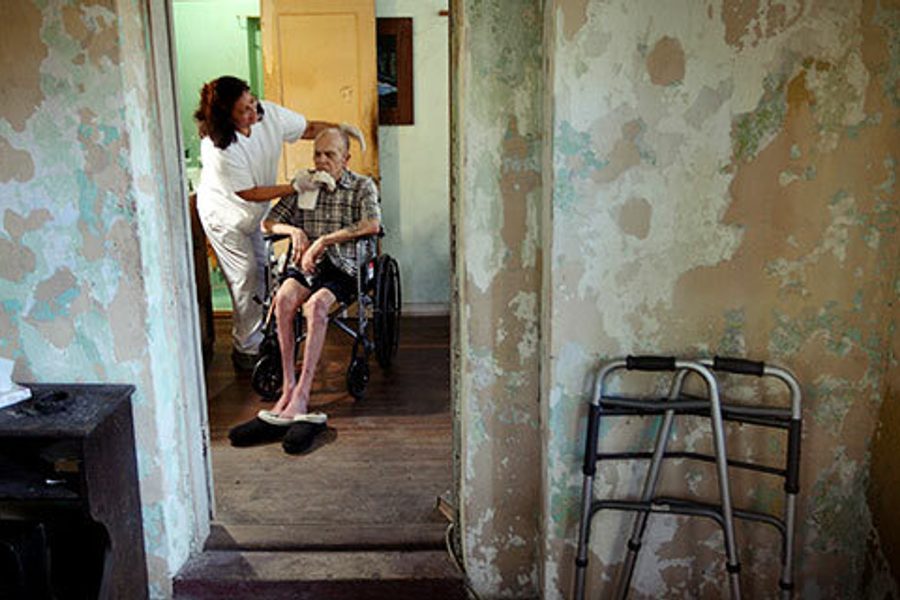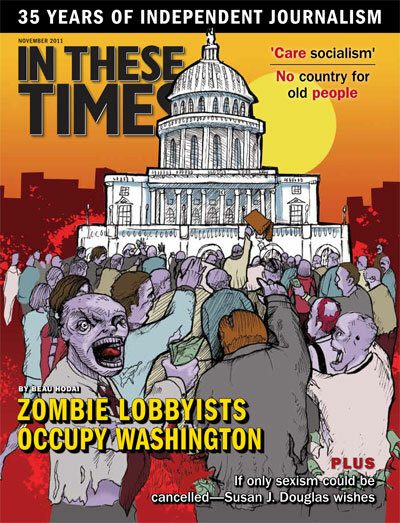No Country for Old People
America’s healthcare crisis hits minority seniors—and things are getting worse.
Michelle Chen

Melvinteen Daniels may have been in the autumn of her life, but it shouldn’t have ended the way it did. At a county-run Pennsylvania nursing home, she perished from neglect, her body ravaged by malnourishment and blood infection, according to court documents. Her skin was marred by a pressure ulcer that had grown to about 11-inches wide.
Last summer, a federal appeals court judge allowed Daniels’ family to go forward with a civil lawsuit, which was, like thousands of other nursing home neglect cases, settled out of court. But the Daniels case was unusual for its legal rationale: by invoking an obscure civil rights statute in the 1987 Nursing Home Reform Act, the suit uniquely linked the concept of civil rights with the care of the elderly. Daniels’ death foreshadows a coming crisis in the healthcare system: As a massive number of older Americans – the “gray wave” – are absorbed into long-term care programs, can the system deliver what our elders need and deserve at the most vulnerable stage in their lives?
By 2030, the baby boom will be hurtling toward a senior bust. Nearly one in every five Americans will be sixty-five or older, up from about 13 percent in 2009, resulting in national demographics similar to those that currently exist in Florida. Despite the soaring need for long-term care that such an aging population is likely to entail – a 2008 study project about half a million new nursing home beds would be needed by 2020 – the number of nursing home beds has actually shrunk by 5 percent over the past decade. And as the system confronts a cohort of old people of unprecedented racial and ethnic diversity, it is likely that it is elderly people of color who will suffer disproportionately from these constraints.
Amid the structural challenges of the impending “gray wave,” newly emboldened Republican lawmakers want to gut the Medicare and Medicaid systems that support nursing homes and other long-term care services. Such cuts are likely to result in even greater racial and class inequities in long-term care.
As the budget standoff escalated in Washington this summer, keystone health programs – despite their vital role as social safety nets in a weak economy – became a whipping post for deficit hawks, particularly in light of the political uproar and budgetary pressures surrounding the new healthcare reform legislation. Now that both parties are embroiled in a race to cut the deficit, supposedly to shore up the country’s long-term finances, both Medicare and Medicaid have been hauled onto the table in the political horse trade. Some possible “cost-saving” measures include converting Medicaid to a flat-funded block grant program or restricting Medicare coverage based on the patient’s income. In the bipartisan deficit-slashing frenzy, healthcare cuts might also be compounded by the downsizing of Social Security and other federal programs that millions of poor and elderly rely on for survival.
Nursing home white flight
Stories like Daniels’ are rare, but such tragedies punctuate grim patterns of neglect baked into the country’s senior care infrastructure. The key factors determining the quality of nursing care tend to be outside of seniors’ (or their families’) control. For a senior living on a fixed income, the likelihood of winding up in a home where she can’t stand the food, is given the wrong medications, or has to sleep in a wet bed at night, may ultimately hinge on how much her family can pay. That has a lot to do with her race and where she lives.
A 2007 study by researchers at Brown and Temple Universities found that blacks were 40 percent more likely to live in a facility cited by federal regulators for posing an immediate health hazard, and 70 percent more likely to be put in a facility that ultimately lost its Medicare and Medicaid certification. A new follow-up analysis shows that, from 1999 through 2008, poor quality of care contributed to a rash of closures of nursing facilities across the country, resulting in a net loss of nursing home beds.
It all adds up to what researchers called a “tiered system of nursing home care that concentrates blacks in marginal-quality nursing homes.” “If you look at the distribution of patients across poor versus higher quality homes … minorities go to poor homes, whites go to relatively better homes,” said Zhanlian Feng, one of the study’s lead researchers. He added that when the care deteriorates to a crisis point – for instance, a crippling lawsuit – “the closure of a bunch of homes in these troubled communities most likely will exacerbate these kinds of persistent disparities.”
The problem isn’t with individual facilities but with the socioeconomic inequalities that inadequate facilities are a symptom of. People in marginalized communities are less healthy overall due to a lack of medical insurance, higher poverty and other hardships throughout their lives. And as affluent seniors shift away from nursing home care altogether to less institutional settings like assisted living facilities, nursing homes may become more racially and economically segregated in the future. Another study from Brown published this summer suggests that after years of being underrepresented in the nursing home population, black and Latino elderly are seeking nursing home care at unprecedented rates, while whites are moving out – mirroring patterns of white flight that have long precipitated racial housing segregation.
“So now, you just have more money flowing away from the nursing homes,” says Ruqaiijah Yearby, a professor at Case Western Reserve University School of Law, “which says to me that the poorest and most disenfranchised, such as impoverished blacks, are going to be left in these nursing homes.”
No place like home
For hundreds of thousands of frail and ill seniors, a nursing home may be the most affordable option available through Medicaid and Medicare. But the cost to individual lives is in many ways immeasurable.
Marlene Moore, reflected on her isolation in her nursing home not as outright maltreatment, but a more subtle form of neglect. In her testimony at a 2010 public forum on long term care in Illinois, Moore (who has since died) said, “The worst thing about living in a nursing home is that you lose your freedom and people don’t think you know your own mind. For 60 years I managed my own life and as soon as I entered a nursing home they told me that I was not capable of that any more. … Nothing is done at my convenience or when I wish to. Everything is done at their convenience. It doesn’t matter if I’m waiting for someone to answer my call light or getting my dinner order. My favorite thing to say when someone wants something and can’t get it is, “What do you expect? It’s a nursing home.”Those expectations may be shifting. In recent years, the pressures of rising healthcare costs have converged with a turn toward more flexible, community-based programs, such as alternative care systems that are less restrictive and antiseptic than a typical nursing facility. In newer care models, a home nursing aide or adult day-care center might effectively provide the services of a conventional nursing staff, but also allow your grandmother to keep her pets, celebrate her birthdays with family and eat home-cooked meals.
Some community organizations have been able to serve local low-income seniors in their neighborhoods under the Program of All-inclusive Care for the Elderly (PACE). The joint federal-state program lets care providers use Medicare and Medicaid dollars for community-based health and support services for seniors eligible for regular nursing care.
First piloted in San Francisco’s Chinatown in the 1970s, the PACE model was designed to meet the long-term care needs of aging Chinese-Americans, for whom nursing homes were a culturally alien concept. Centered around “interdisciplinary” teams that may include social workers, physicians, dieticians or physical therapists, the program fosters personal planning of care using local resources, so seniors can remain at home for as long as possible. Research comparing regular nursing-home care with various PACE programs shows the new model tends to be more cost-efficient in the long run.
“Care and services should be organized around each person’s needs and what is most important to them to maintain their quality of life, not around a list of services that are reimbursable under Medicaid and Medicare,” says Robert Greenwood, vice president of public affairs at the National PACE Association.
Pending reform measures may reroute federal money toward leaner home- and community-based services. Still, according to research by the Center for Health Care Strategies, home and community-based care will face funding and management challenges as the need for services intensifies. Even if marginal reforms are enacted, long-term obstacles include high costs as well as sparse local healthcare infrastructures, which limit options for care close to home. Real systemic change may sadly have to wait until those barriers crash with the rising gray wave.
For now, those barriers to fair treatment mean that finding a way to a safe and dignified final home for an aging loved one may be the hardest journey a family will ever face. People like Stephanie Wood, a middle-aged mother in Pittsburgh, will have to wend through the system through process of trial and error and a lot of luck.
A survivor of a stroke and heart problems, she was placed in long-term care and adjust to dependency on long-term care. The staff treated her decently, she recalled, but condescendingly, sometimes “talking to me like I was a child.” There were also more subtle forms of neglect. While recovering, she said, “I was doing a lot of sitting there just crying and crying and crying, because I wanted to be home and I wanted to be with my family…. And I wasn’t concentrating on my physical therapy.” Then in 2009, she worked with the local group Three Rivers Center for Independent Living to transition into an apartment where she could get in-home care. Instead of relying on strangers to bathe and feed her, her daughters would look after her, and even cheer her on during her rehab sessions.
Several months after her move, she said in an interview, “I’m in a much happier place because my children are all around me.”
Despite byzantine layers of regulations, reforms and political rhetoric, that most basic of needs – to be surrounded by people who care, professionally and emotionally – is falling by the wayside for millions making the journey into old age. As Washington scrambles to find solutions, the experiences of today’s elders leave us with some surprisingly simple wisdom: Being cared for shouldn’t mean being helpless, and being independent shouldn’t mean having to be alone.
The Chicago Reporter assisted with research for this article.
Michelle Chen is a contributing writer at In These Times and The Nation, a contributing editor at Dissent and a co-producer of the “Belabored” podcast. She studies history at the CUNY Graduate Center. She tweets at @meeshellchen.









